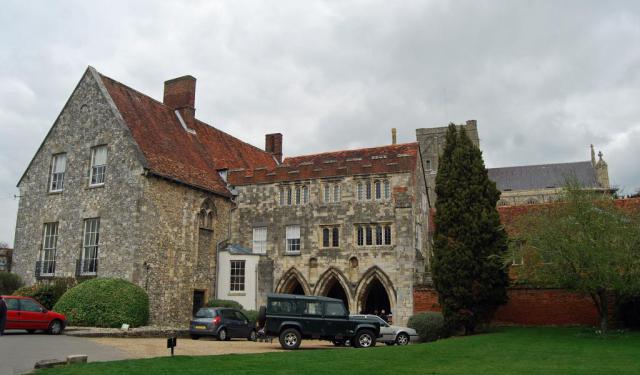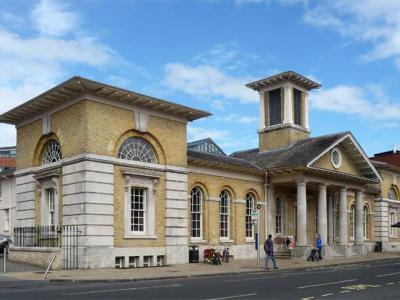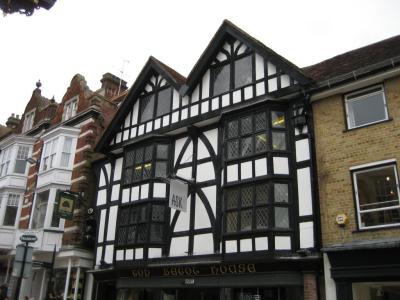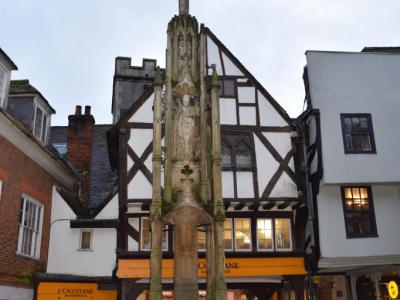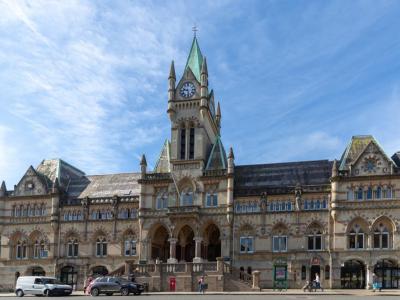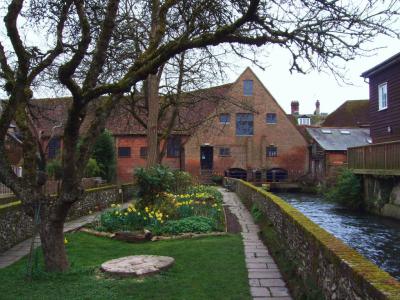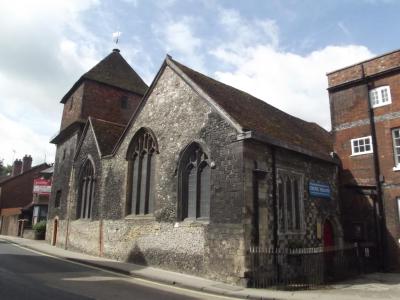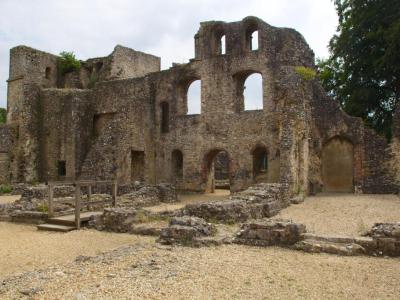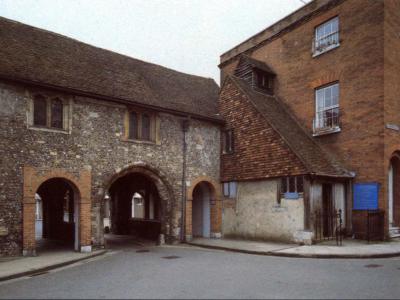Winchester's Historical Buildings Walking Tour (Self Guided), Winchester
Are you an explorer at heart and with a keen interest in history? If you answer yes to both of these and happen to be in Winchester, Hampshire, then you've hit the right spot! There are several historical locations in town, including time-honored buildings, monuments, and palaces, through which you can learn much about its glorious past.
The abundance of such sites makes a walk around Winchester a rather interesting adventure. By far, the main local architectural treasure is the Great Hall of Winchester Castle, a medieval gem that stands as a testament to the city's ancient heritage. Its iconic Round Table, often associated with the legends of King Arthur, adds an air of myth and legend to this imposing structure.
Westgate, another prominent landmark, is a historic gatehouse that once guarded the city's entrance. Its sturdy stone walls evoke a sense of medieval grandeur and serve as a reminder of Winchester's strategic importance throughout history.
The Corn Exchange, now a cultural hub, was originally a bustling marketplace, witnessing centuries of commerce and trade. Today, it hosts a variety of events and performances, breathing new life into its venerable walls.
The Royal Oak Bar offers a cozy retreat, nestled within an old timber-framed building, where patrons can savor a taste of history while enjoying a drink.
God Begot House, with its distinctive Tudor appearance, exudes charm and character, while the Winchester Buttercross, an ornate stone cross, stands as a symbol of the city's centuries-old traditions.
Winchester Guildhall, an elegant structure, continues to host civic ceremonies and events, connecting the present with its storied past.
The rhythmic churn of the Winchester City Mill's water wheel harkens back to a time when it was essential for grinding grain, providing sustenance for the community.
Chesil Theatre, housed in a former church, now entertains audiences with a diverse array of theatrical productions.
The Bishop's House, Wolvesey Castle, and Kingsgate offer glimpses into the ecclesiastical and royal history of the city, showcasing architectural splendor and historical significance.
These buildings are living witnesses to Winchester's vibrant history. To truly appreciate their heritage, we invite you to embark on this self-guided journey and explore the stories they hold. Visit the landmarks, learn their secrets, and become a part of Winchester's enduring narrative.
The abundance of such sites makes a walk around Winchester a rather interesting adventure. By far, the main local architectural treasure is the Great Hall of Winchester Castle, a medieval gem that stands as a testament to the city's ancient heritage. Its iconic Round Table, often associated with the legends of King Arthur, adds an air of myth and legend to this imposing structure.
Westgate, another prominent landmark, is a historic gatehouse that once guarded the city's entrance. Its sturdy stone walls evoke a sense of medieval grandeur and serve as a reminder of Winchester's strategic importance throughout history.
The Corn Exchange, now a cultural hub, was originally a bustling marketplace, witnessing centuries of commerce and trade. Today, it hosts a variety of events and performances, breathing new life into its venerable walls.
The Royal Oak Bar offers a cozy retreat, nestled within an old timber-framed building, where patrons can savor a taste of history while enjoying a drink.
God Begot House, with its distinctive Tudor appearance, exudes charm and character, while the Winchester Buttercross, an ornate stone cross, stands as a symbol of the city's centuries-old traditions.
Winchester Guildhall, an elegant structure, continues to host civic ceremonies and events, connecting the present with its storied past.
The rhythmic churn of the Winchester City Mill's water wheel harkens back to a time when it was essential for grinding grain, providing sustenance for the community.
Chesil Theatre, housed in a former church, now entertains audiences with a diverse array of theatrical productions.
The Bishop's House, Wolvesey Castle, and Kingsgate offer glimpses into the ecclesiastical and royal history of the city, showcasing architectural splendor and historical significance.
These buildings are living witnesses to Winchester's vibrant history. To truly appreciate their heritage, we invite you to embark on this self-guided journey and explore the stories they hold. Visit the landmarks, learn their secrets, and become a part of Winchester's enduring narrative.
How it works: Download the app "GPSmyCity: Walks in 1K+ Cities" from Apple App Store or Google Play Store to your mobile phone or tablet. The app turns your mobile device into a personal tour guide and its built-in GPS navigation functions guide you from one tour stop to next. The app works offline, so no data plan is needed when traveling abroad.
Winchester's Historical Buildings Walking Tour Map
Guide Name: Winchester's Historical Buildings Walking Tour
Guide Location: England » Winchester (See other walking tours in Winchester)
Guide Type: Self-guided Walking Tour (Sightseeing)
# of Attractions: 12
Tour Duration: 2 Hour(s)
Travel Distance: 3.1 Km or 1.9 Miles
Author: DanaOffice
Sight(s) Featured in This Guide:
Guide Location: England » Winchester (See other walking tours in Winchester)
Guide Type: Self-guided Walking Tour (Sightseeing)
# of Attractions: 12
Tour Duration: 2 Hour(s)
Travel Distance: 3.1 Km or 1.9 Miles
Author: DanaOffice
Sight(s) Featured in This Guide:
- The Great Hall of Winchester Castle
- Westgate
- Corn Exchange
- The Royal Oak Bar
- God Begot House
- Winchester Buttercross
- Winchester Guildhall
- Winchester City Mill
- Chesil Theatre
- The Bishop's House
- Wolvesey Castle
- Kingsgate
1) The Great Hall of Winchester Castle (must see)
Winchester Castle stands as a significant medieval structure in Winchester, built in 1067. For over a century, it served as the administrative center for the Norman Kings. Henry II notably constructed a stone keep, used to house the royal treasury and the famed Domesday Book. A round tower from the original castle remains visible, equipped with sally ports.
The castle played a pivotal role during The Anarchy in 1141 when forces of the Empress Matilda were besieged by King Stephen's army at the castle, known as the Rout of Winchester. Henry III, who was born within Winchester Castle, contributed the impressive Great Hall between 1222 and 1235. The Great Hall, designed as a "double cube," measures 110 feet by 55 feet, built primarily of flint with stone dressings.
Adding to its heritage, Edward II incorporated extensions to the castle. The Great Hall itself is listed as a Grade I building. Behind the Great Hall, Queen Eleanor's Garden, designed in medieval style, was established in 1986.
The castle's Great Hall features the legendary Arthurian Round Table, originally crafted in the 13th century and later repainted for Henry VIII. This round table once displayed the names of King Arthur's knights. Hanging in the Great Hall, the Winchester Panels, painted in a monastic style, depict the 25 knights of the Round Table, portraying the challenges faced in the great "Wheel of Life."
Interestingly, the Great Hall served as the venue for the trial and conviction of six Provisional IRA members in 1973 for the Old Bailey bombing. However, it ceased to hold criminal trials after the Winchester Law Courts were erected in 1974, situated nearby to the east of the Great Hall. The castle is also close to the Westgate, which remains part of the surviving city wall, further enriching Winchester's historical landscape.
The castle played a pivotal role during The Anarchy in 1141 when forces of the Empress Matilda were besieged by King Stephen's army at the castle, known as the Rout of Winchester. Henry III, who was born within Winchester Castle, contributed the impressive Great Hall between 1222 and 1235. The Great Hall, designed as a "double cube," measures 110 feet by 55 feet, built primarily of flint with stone dressings.
Adding to its heritage, Edward II incorporated extensions to the castle. The Great Hall itself is listed as a Grade I building. Behind the Great Hall, Queen Eleanor's Garden, designed in medieval style, was established in 1986.
The castle's Great Hall features the legendary Arthurian Round Table, originally crafted in the 13th century and later repainted for Henry VIII. This round table once displayed the names of King Arthur's knights. Hanging in the Great Hall, the Winchester Panels, painted in a monastic style, depict the 25 knights of the Round Table, portraying the challenges faced in the great "Wheel of Life."
Interestingly, the Great Hall served as the venue for the trial and conviction of six Provisional IRA members in 1973 for the Old Bailey bombing. However, it ceased to hold criminal trials after the Winchester Law Courts were erected in 1974, situated nearby to the east of the Great Hall. The castle is also close to the Westgate, which remains part of the surviving city wall, further enriching Winchester's historical landscape.
2) Westgate
The Westgate, an enduring symbol of Winchester's medieval heritage, stands proudly as one of the two surviving fortified gateways in the city, the other being Kingsgate. Originally an integral part of Winchester City Walls, the Westgate bears witness to centuries of history, embodying a unique blend of Anglo-Saxon, 12th-century, and later architectural influences.
With its roots tracing back to Anglo-Saxon times, the Westgate underwent significant transformations over the centuries. A testament to medieval engineering, the gate was rebuilt in the 12th century, with further modifications in the 13th and late 14th centuries. Notably, the late 14th-century alterations introduced features like a portcullis in the western façade and two inverted-keyhole gunports, representing some of the earliest examples of such defensive structures designed for hand-held cannons in the country. The gate served its defensive purpose until 1959 when the High Street was redirected around it.
In the 19th century, recognizing its historical significance, the City Corporation (now Winchester City Council) acquired the Westgate. Subsequently, the gate was repurposed as a museum and repository for the city's archives. In 2014, ownership of the museum space transitioned to Hampshire Cultural Trust.
Today, the Westgate Museum stands not only as a physical remnant of Winchester's medieval past but also as a cultural repository. Visitors can explore a diverse array of exhibits, including a renowned collection of pre-Imperial weights and measures. One notable highlight is a beautifully crafted painted ceiling, created for Winchester College in anticipation of the historic visit by Mary Tudor and Philip of Spain on the occasion of their marriage in Winchester in 1554.
With its roots tracing back to Anglo-Saxon times, the Westgate underwent significant transformations over the centuries. A testament to medieval engineering, the gate was rebuilt in the 12th century, with further modifications in the 13th and late 14th centuries. Notably, the late 14th-century alterations introduced features like a portcullis in the western façade and two inverted-keyhole gunports, representing some of the earliest examples of such defensive structures designed for hand-held cannons in the country. The gate served its defensive purpose until 1959 when the High Street was redirected around it.
In the 19th century, recognizing its historical significance, the City Corporation (now Winchester City Council) acquired the Westgate. Subsequently, the gate was repurposed as a museum and repository for the city's archives. In 2014, ownership of the museum space transitioned to Hampshire Cultural Trust.
Today, the Westgate Museum stands not only as a physical remnant of Winchester's medieval past but also as a cultural repository. Visitors can explore a diverse array of exhibits, including a renowned collection of pre-Imperial weights and measures. One notable highlight is a beautifully crafted painted ceiling, created for Winchester College in anticipation of the historic visit by Mary Tudor and Philip of Spain on the occasion of their marriage in Winchester in 1554.
3) Corn Exchange
The Corn Exchange in Winchester, a captivating edifice that unfolded its doors in 1838 on Jewry Street, stands as a testament to architectural elegance and adaptive reuse. Erected at a cost of £4,000, its strategic proximity to the railway station added to its appeal. Designed in the Italianate style by Owen Carter, the building showcases yellow brick and white ashlar, with a Tuscan-style portico likely inspired by St Paul's church in Covent Garden.
Over the years, the Corn Exchange diversified its functions. It transformed into a roller skating rink from 1906 to 1914 before evolving into the Empire Corn Exchange theatre in 1915. Renamed the Regent Theatre, it ventured into cinema in 1917, known as the Regent Picture Theatre, complete with a restaurant, tea lounge, and a daily orchestra. The cinema chapter concluded in 1922, making way for the Regent Dance Hall, only to revert to a cinema, the Regent Cinema, in 1933. The cinema era concluded in 1936, prompting the City Council to invest £3,100 in its transformation into a public library, a role it continues to play to this day.
Over the years, the Corn Exchange diversified its functions. It transformed into a roller skating rink from 1906 to 1914 before evolving into the Empire Corn Exchange theatre in 1915. Renamed the Regent Theatre, it ventured into cinema in 1917, known as the Regent Picture Theatre, complete with a restaurant, tea lounge, and a daily orchestra. The cinema chapter concluded in 1922, making way for the Regent Dance Hall, only to revert to a cinema, the Regent Cinema, in 1933. The cinema era concluded in 1936, prompting the City Council to invest £3,100 in its transformation into a public library, a role it continues to play to this day.
4) The Royal Oak Bar
The Royal Oak proudly lays claim to the title of "the oldest bar in England," a distinction that stirs curiosity and beckons visitors to step into its storied ambiance. Owing to its ancient cellar dating back to 1002 and its history as Queen Emma's residence, the Royal Oak presents a charming glimpse into the past. While the exact moment it transitioned into a pub remains a matter of debate, records show it operating as a 'brewhouse' by 1637 and acquiring the name Royal Oak by 1677.
Tucked away in a narrow alley off the bustling High Street, the main entrance welcomes patrons to a cosy interior adorned with ample oak paneling, featuring a sizable bar offering local ales. Side rooms at each end of the main seating area, accessible via steps, lead to the original cellar-one of the pub's distinctive elements. For those desiring an al fresco experience, additional seating awaits on a quaint patio.
The atmosphere within The Royal Oak reflects a balance between the past and the present. A relatively modern menu, complete with the convenience of app-based ordering, brings a contemporary touch to this age-old establishment. Catering to diverse dietary preferences, the pub offers a gluten-free menu along with vegan and vegetarian options, ensuring a culinary experience that accommodates various tastes.
Tucked away in a narrow alley off the bustling High Street, the main entrance welcomes patrons to a cosy interior adorned with ample oak paneling, featuring a sizable bar offering local ales. Side rooms at each end of the main seating area, accessible via steps, lead to the original cellar-one of the pub's distinctive elements. For those desiring an al fresco experience, additional seating awaits on a quaint patio.
The atmosphere within The Royal Oak reflects a balance between the past and the present. A relatively modern menu, complete with the convenience of app-based ordering, brings a contemporary touch to this age-old establishment. Catering to diverse dietary preferences, the pub offers a gluten-free menu along with vegan and vegetarian options, ensuring a culinary experience that accommodates various tastes.
5) God Begot House
God Begot House boasts a rich history rooted in the 11th century. Gifted to Emma, daughter of Duke Richard of Normandy, as part of her wedding present in 1002, this manor held a unique status, operating independently of the city with its own laws and taxes.
The current structure, dating back to 1050, witnessed Emma's enduring presence and subsequent bequest of the manor to "Christ, St. Peter and St. Swithun." This transfer ensured tax and toll exemptions, marking its transition to the Prior and monks of St. Swithun. The manor's exceptional privileges included sanctuary for those claiming its liberty and exclusive jurisdiction by the priory's ministers. Despite a brief interlude during the Dissolution of the Monasteries, where it briefly fell under Henry VIII's control, the manor's rights were eventually reinstated.
Today, God Begot House, having weathered diverse uses over the centuries, stands as a testament to Winchester's enduring heritage, recently serving as a distinguished retail establishment.
The current structure, dating back to 1050, witnessed Emma's enduring presence and subsequent bequest of the manor to "Christ, St. Peter and St. Swithun." This transfer ensured tax and toll exemptions, marking its transition to the Prior and monks of St. Swithun. The manor's exceptional privileges included sanctuary for those claiming its liberty and exclusive jurisdiction by the priory's ministers. Despite a brief interlude during the Dissolution of the Monasteries, where it briefly fell under Henry VIII's control, the manor's rights were eventually reinstated.
Today, God Begot House, having weathered diverse uses over the centuries, stands as a testament to Winchester's enduring heritage, recently serving as a distinguished retail establishment.
6) Winchester Buttercross
The Winchester Buttercross, also recognized as the Holy Cross monument, stands as a revered symbol dating back to the mid-14th century. Rich in historical significance, local oral traditions suggest that this monument may have been a generous gift from Cardinal Beaufort, who served as the Bishop of Winchester from 1404 to 1447.
This remarkable structure is adorned with twelve intricate figures, including depictions of the Blessed Virgin and an array of saints such as Bartholomew, Peter, Swithun, John, Lawrence, Maurice, and Thomas. Additional figures were later added, featuring William of Wykeham, Lawrence de Anne, King Alfred, and the oldest representation, possibly symbolizing St John the Evangelist or St Amphibalus.
Resting gracefully on five octagonal steps, the Winchester Buttercross invites contemplation and marvels at the spiritual legacy embedded in the town's past.
This remarkable structure is adorned with twelve intricate figures, including depictions of the Blessed Virgin and an array of saints such as Bartholomew, Peter, Swithun, John, Lawrence, Maurice, and Thomas. Additional figures were later added, featuring William of Wykeham, Lawrence de Anne, King Alfred, and the oldest representation, possibly symbolizing St John the Evangelist or St Amphibalus.
Resting gracefully on five octagonal steps, the Winchester Buttercross invites contemplation and marvels at the spiritual legacy embedded in the town's past.
7) Winchester Guildhall (must see)
Winchester Guildhall, a Grade II listed building, stands as a historic and architecturally significant structure in Winchester. Prior to the establishment of the current Guildhall in 1873, its predecessor had occupied a site further up the High Street since the time of King Edward IV.
The site for the new Guildhall held historical significance, having been previously occupied by St Mary's Abbey. Following the dissolution of the monasteries in the late 1530s, Queen Mary granted the site to the City of Salisbury as a gesture of gratitude for the city's support in her marriage to King Philip of Spain in 1554.
The foundation stone for the new building was laid on December 22, 1871, by Viscount Eversley, the former Speaker of the House of Commons. The Guildhall was officially opened on May 18, 1873, by the Lord Chancellor, Earl of Selborne.
Designed by Jeffery and Skiller in the Gothic Revival style the Guildhall features a distinctive architectural composition. The central section incorporates a flight of steps leading to an arcaded entrance on the first floor, three mullion windows on the second floor, and a prominent clock tower topped by angle pavilions. The clock, crafted by Gillett & Bland, includes quarter-chiming features. Statues of local historical figures adorn the front of the building at the second-floor level, adding a cultural touch to the architectural ensemble.
The interior of the Guildhall holds artistic treasures, including the King Charles Room, where a restored portrait of King Charles I revealed its original depiction of Henry Jermyn, 1st Earl of St Albans, by Peter Lely, over-painted with an image of the king. Other notable paintings in the King Charles Room feature portraits of King Charles II by Peter Lely and Queen Elizabeth II by Edward Halliday. Additionally, the stairwell houses a painting by Thomas Stewardson depicting the children of Charles Paulet, 13th Marquess of Winchester.
The site for the new Guildhall held historical significance, having been previously occupied by St Mary's Abbey. Following the dissolution of the monasteries in the late 1530s, Queen Mary granted the site to the City of Salisbury as a gesture of gratitude for the city's support in her marriage to King Philip of Spain in 1554.
The foundation stone for the new building was laid on December 22, 1871, by Viscount Eversley, the former Speaker of the House of Commons. The Guildhall was officially opened on May 18, 1873, by the Lord Chancellor, Earl of Selborne.
Designed by Jeffery and Skiller in the Gothic Revival style the Guildhall features a distinctive architectural composition. The central section incorporates a flight of steps leading to an arcaded entrance on the first floor, three mullion windows on the second floor, and a prominent clock tower topped by angle pavilions. The clock, crafted by Gillett & Bland, includes quarter-chiming features. Statues of local historical figures adorn the front of the building at the second-floor level, adding a cultural touch to the architectural ensemble.
The interior of the Guildhall holds artistic treasures, including the King Charles Room, where a restored portrait of King Charles I revealed its original depiction of Henry Jermyn, 1st Earl of St Albans, by Peter Lely, over-painted with an image of the king. Other notable paintings in the King Charles Room feature portraits of King Charles II by Peter Lely and Queen Elizabeth II by Edward Halliday. Additionally, the stairwell houses a painting by Thomas Stewardson depicting the children of Charles Paulet, 13th Marquess of Winchester.
8) Winchester City Mill
Winchester City Mill, a meticulously restored water mill nestled along the picturesque River Itchen, stands as a testament to centuries of milling history. Owned by the National Trust, this Grade II* listed building has been a key part of Winchester's landscape for over a millennium.
The mill's roots trace back to the Domesday Book of 1086, where it was recorded as milling corn. However, earlier references in cathedral records date as far back as 932. In 989, Queen Aelfthryth passed the mill to the nuns of Wherwell Abbey. Some of the timbers in the mill, identified through dendrochronological measurements, date back to the 11th century, adding to its historical significance.
Originally named Eastgate Mill due to its location just outside the city's east gate, it later became known as City Mill when Queen Mary bestowed it upon the city following her marriage to Philip I of Spain in Winchester Cathedral in 1554. The mill underwent its last major reconstruction in 1744 by James Cook, a tanner. A sketch by J.M.W Turner from 1795 reveals that the building and millraces have remained relatively unchanged since that time.
In 1820, the Corporation sold the mill to the Benham family, who owned it until the early 1900s. Financial challenges arose in the late 1890s due to competition from neighboring mills, and by 1910, City Mill had ceased operations. Following a stint as a laundry during World War I, the mill fell into disrepair. In 1928, facing the threat of demolition, the mill was saved by a group of benefactors who purchased it and presented it to the National Trust. In 1931, the Youth Hostels Association leased the mill for use as a hostel, a role it fulfilled until 2005.
A twelve-year restoration program culminated in 2004, marking the first time in at least 90 years that the mill once again milled flour using water power. The mill building now houses a National Trust cafe and shop. In collaboration with the Hampshire and Isle of Wight Wildlife Trust and the Environment Agency, night-vision cameras monitor the river passing under the mill, capturing images of otters. These recordings are displayed on a monitor in the stone floor area, offering visitors a glimpse into the local wildlife.
The mill's roots trace back to the Domesday Book of 1086, where it was recorded as milling corn. However, earlier references in cathedral records date as far back as 932. In 989, Queen Aelfthryth passed the mill to the nuns of Wherwell Abbey. Some of the timbers in the mill, identified through dendrochronological measurements, date back to the 11th century, adding to its historical significance.
Originally named Eastgate Mill due to its location just outside the city's east gate, it later became known as City Mill when Queen Mary bestowed it upon the city following her marriage to Philip I of Spain in Winchester Cathedral in 1554. The mill underwent its last major reconstruction in 1744 by James Cook, a tanner. A sketch by J.M.W Turner from 1795 reveals that the building and millraces have remained relatively unchanged since that time.
In 1820, the Corporation sold the mill to the Benham family, who owned it until the early 1900s. Financial challenges arose in the late 1890s due to competition from neighboring mills, and by 1910, City Mill had ceased operations. Following a stint as a laundry during World War I, the mill fell into disrepair. In 1928, facing the threat of demolition, the mill was saved by a group of benefactors who purchased it and presented it to the National Trust. In 1931, the Youth Hostels Association leased the mill for use as a hostel, a role it fulfilled until 2005.
A twelve-year restoration program culminated in 2004, marking the first time in at least 90 years that the mill once again milled flour using water power. The mill building now houses a National Trust cafe and shop. In collaboration with the Hampshire and Isle of Wight Wildlife Trust and the Environment Agency, night-vision cameras monitor the river passing under the mill, capturing images of otters. These recordings are displayed on a monitor in the stone floor area, offering visitors a glimpse into the local wildlife.
9) Chesil Theatre
Chesil Theatre, nestled within the heart of the historic city of Winchester, boasts a rich history and serves as a cultural gem for enthusiasts of the performing arts. Formerly known as St Peter's Church, Chesil, or St Peter upon Chesille without Eastgate, this establishment has undergone a remarkable transformation from a parish church to a vibrant theatrical space.
The church itself, a testament to Winchester's architectural heritage, features elements dating back to the 12th century and subsequent periods. Constructed with a harmonious blend of flint and stone, the building showcases a belfry turret and roofs adorned with tiles, encapsulating the charm of medieval craftsmanship. Among its historical treasures, the church once housed a small one-manual pipe organ, offering a musical backdrop to its sacred surroundings.
After falling into disuse following the Second World War and facing structural challenges, St Peter's Church found new life and purpose. In 1960, the Chesil Theatre company, originally known as the Winchester Dramatic Society, took ownership of the space. This marked the beginning of a new chapter for the building, which was transformed into an intimate and versatile 75-seat studio-style theatre.
Chesil Theatre, with roots dating back to 1863, continues to captivate audiences within the evocative confines of this medieval listed structure. The former church, now a dynamic performance space, stands as a testament to the enduring spirit of cultural expression and community engagement in Winchester.
The church itself, a testament to Winchester's architectural heritage, features elements dating back to the 12th century and subsequent periods. Constructed with a harmonious blend of flint and stone, the building showcases a belfry turret and roofs adorned with tiles, encapsulating the charm of medieval craftsmanship. Among its historical treasures, the church once housed a small one-manual pipe organ, offering a musical backdrop to its sacred surroundings.
After falling into disuse following the Second World War and facing structural challenges, St Peter's Church found new life and purpose. In 1960, the Chesil Theatre company, originally known as the Winchester Dramatic Society, took ownership of the space. This marked the beginning of a new chapter for the building, which was transformed into an intimate and versatile 75-seat studio-style theatre.
Chesil Theatre, with roots dating back to 1863, continues to captivate audiences within the evocative confines of this medieval listed structure. The former church, now a dynamic performance space, stands as a testament to the enduring spirit of cultural expression and community engagement in Winchester.
10) The Bishop's House
Bishop's Waltham Palace bears witness to centuries of rich history and notable events. Constructed in the 12th century by Bishop Henry of Blois, the Palace stands as a testament to the grandeur and significance of the Winchester Bishops' residences.
Throughout its storied past, Bishop's Waltham Palace served as a distinguished abode for the influential Winchester Bishops, welcoming various royal dignitaries. Among its illustrious guests were Henry V, who stayed before the Battle of Agincourt, and Queen Mary I, who awaited the arrival of King Philip of Spain for their wedding.
The surviving remnants of the palace predominantly owe their existence to the efforts of Bishop William of Wykeham in the late 14th century. While the 17th-century Civil War brought challenges, with the palace likely suffering damage during the royalist garrison's defense, it has persevered through time.
Today, Bishop's Waltham Palace is under the guardianship of English Heritage, ensuring its preservation for future generations. The palace grounds open to the public from May to September provide a captivating glimpse into its historical splendor. Visitors can explore the museum and farmhouse on Saturdays and Sundays, gaining insight into the rich tapestry of Bishop's Waltham Palace's past. Both the grounds and the museum welcome visitors free of charge, inviting all to immerse themselves in the allure of this venerable landmark.
Throughout its storied past, Bishop's Waltham Palace served as a distinguished abode for the influential Winchester Bishops, welcoming various royal dignitaries. Among its illustrious guests were Henry V, who stayed before the Battle of Agincourt, and Queen Mary I, who awaited the arrival of King Philip of Spain for their wedding.
The surviving remnants of the palace predominantly owe their existence to the efforts of Bishop William of Wykeham in the late 14th century. While the 17th-century Civil War brought challenges, with the palace likely suffering damage during the royalist garrison's defense, it has persevered through time.
Today, Bishop's Waltham Palace is under the guardianship of English Heritage, ensuring its preservation for future generations. The palace grounds open to the public from May to September provide a captivating glimpse into its historical splendor. Visitors can explore the museum and farmhouse on Saturdays and Sundays, gaining insight into the rich tapestry of Bishop's Waltham Palace's past. Both the grounds and the museum welcome visitors free of charge, inviting all to immerse themselves in the allure of this venerable landmark.
11) Wolvesey Castle (must see)
Wolvesey Castle, also known as the "Old Bishop's Palace," stands as a historic ruin initially constructed as the official residence of Æthelwold of Winchester, the Bishop of Winchester, around 970. The building site, initially an eyot in the River Itchen, known as Wulveseye or Wulf's island, became the foundation for this bishop's palace. Henry of Blois, the Bishop of Winchester, expanded and developed the castle primarily between 1135 and 1171.
The castle's varied history includes construction modifications and, in 1684, a new palace in the baroque style was built to the south. However, much of it was later demolished, leaving only the west wing. Over time, the remaining structure found itself repurposed for various uses. Subsequent restoration efforts in 1926 refurbished part of the structure for the bishop's residence.
The chapel, an essential part of the medieval castle's south range, remains intact and is still in active use, attached to the palace. The extensive ruins are currently under the care and ownership of English Heritage and have held Grade I listed status since March 24, 1950. While sections of the curtain wall remain, much of the castle's internal structures are gone, although traces of the hall, displaying a well-preserved round arch and a surviving Norman window, can still be identified.
Situated close to the city walls, some sections of which are still standing, Wolvesey Castle stands as a fascinating piece of Winchester's history, illustrating a compelling narrative of the region's past.
The castle's varied history includes construction modifications and, in 1684, a new palace in the baroque style was built to the south. However, much of it was later demolished, leaving only the west wing. Over time, the remaining structure found itself repurposed for various uses. Subsequent restoration efforts in 1926 refurbished part of the structure for the bishop's residence.
The chapel, an essential part of the medieval castle's south range, remains intact and is still in active use, attached to the palace. The extensive ruins are currently under the care and ownership of English Heritage and have held Grade I listed status since March 24, 1950. While sections of the curtain wall remain, much of the castle's internal structures are gone, although traces of the hall, displaying a well-preserved round arch and a surviving Norman window, can still be identified.
Situated close to the city walls, some sections of which are still standing, Wolvesey Castle stands as a fascinating piece of Winchester's history, illustrating a compelling narrative of the region's past.
12) Kingsgate
Kingsgate, one of Winchester's enduring medieval gates, stands as a testament to the city's rich history in England, with its name recorded as early as 1148. Positioned on or near the site of a Roman gate, Kingsgate served as the entrance to the royal palace before the 10th-century enclosure of the Cathedral Close. The current gate, likely dating back to the 14th century, features 18th-century pedestrian walkways.
A notable feature above the gate is the charming church of St Swithun-upon-Kingsgate. Constructed in the Middle Ages with Early English architectural influences, this small church holds a unique position within the old city walls. First mentioned in thirteenth-century records, St Swithun-upon-Kingsgate gained literary prominence under the fictional name of St Cuthbert's in Anthony Trollope's novel "The Warden."
Kingsgate, recognized as a scheduled monument, and St Swithun's Church, designated as a Grade I listed building, collectively contribute to Winchester's architectural and historical heritage.
A notable feature above the gate is the charming church of St Swithun-upon-Kingsgate. Constructed in the Middle Ages with Early English architectural influences, this small church holds a unique position within the old city walls. First mentioned in thirteenth-century records, St Swithun-upon-Kingsgate gained literary prominence under the fictional name of St Cuthbert's in Anthony Trollope's novel "The Warden."
Kingsgate, recognized as a scheduled monument, and St Swithun's Church, designated as a Grade I listed building, collectively contribute to Winchester's architectural and historical heritage.
Walking Tours in Winchester, England
Create Your Own Walk in Winchester
Creating your own self-guided walk in Winchester is easy and fun. Choose the city attractions that you want to see and a walk route map will be created just for you. You can even set your hotel as the start point of the walk.
Winchester Cathedral Close Walk
Winchester Cathedral, originally built in 1079, is the longest Gothic cathedral in Europe. It contains much fine architecture spanning the 11th to the 16th centuries and is the place of interment of numerous Bishops of Winchester (such as William of Wykeham), Anglo-Saxon monarchs (such as Egbert of Wessex), and later monarchs such as King Canute and William Rufus. It was once an important... view more
Tour Duration: 1 Hour(s)
Travel Distance: 0.8 Km or 0.5 Miles
Tour Duration: 1 Hour(s)
Travel Distance: 0.8 Km or 0.5 Miles
Winchester Introduction Walking Tour
Winchester, the county town of Hampshire, England, is a charming place with a great deal of history.
The name, Winchester, is traced back to its Old English origins, derived from "Wintan-ceaster" which means "Fort Venta". The city itself emerged in Roman times when it was known as Venta Belgarum, in which Venta was a common Celtic word for a "tribal town" or... view more
Tour Duration: 2 Hour(s)
Travel Distance: 3.7 Km or 2.3 Miles
The name, Winchester, is traced back to its Old English origins, derived from "Wintan-ceaster" which means "Fort Venta". The city itself emerged in Roman times when it was known as Venta Belgarum, in which Venta was a common Celtic word for a "tribal town" or... view more
Tour Duration: 2 Hour(s)
Travel Distance: 3.7 Km or 2.3 Miles
The Most Popular Cities
/ view all
